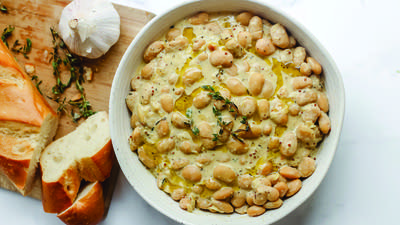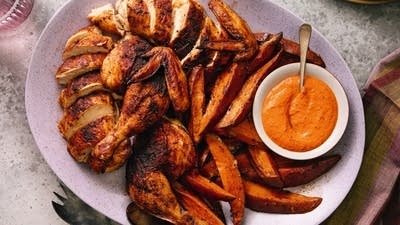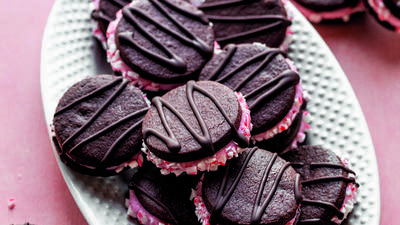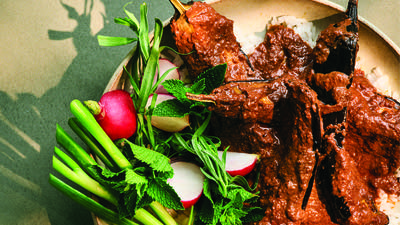
Everyone thinks of Thanksgiving as Turkey Day, but look, the day is really more about sweetness and starch than anything else, right? I mean half the sides are sweet - sweet potatoes, that weird jiggly cranberry jello we for some reason call sauce, and what really matters is what pies people brought this year. So, imagine having Thanksgiving in the home of Miro Uskokovic; he’s the pastry chef of the timeless New York restaurant, Gramercy Tavern, and his wife, Shilpa is also a pastry chef. He’s from Serbia, she’s from India, and I just cannot even imagine what glories grace their table. I sat down and talked with Chef Miro to find out. Check out his recipes for Ham & Cheese Piroške and Pancake Stack Cake from the book, A Place at the Table.
Francis Lam: Chef Miro, you came to the United States from Serbia for your last year of high school. You went to Indiana. What was it like when you got there?
Miroslav Uskokovic: Greentown, Indiana. It was not what I expected, I’ll be honest with you. I come from a small farming community back home in Serbia, and my whole life I was watching movies and dreaming about coming to big city New York or Chicago. So, that’s what I was expecting; that’s not quite Greentown, Indiana. I did land in Chicago, so I saw the big buildings and I was very excited. I was 17 years old. But, as we left Chicago and Gary, Indiana, and started driving, there was nothing but corn around me, and soybeans. And then we arrived in a small country home. There was a goat farm behind it. It was just like back home, but I was kind of disappointed.
FL: On the other side of the world.
MU: Exactly. That’s not what I wanted. I wanted the big lights of New York City. But, it was actually good. It was a good transition. I was 17, from small country town in Serbia. If I’d come to New York City, I don’t think I would have made it and I would have stayed, so it was a nice transition to come to Greentown and then move on.
FL: You came as a student. You came the summer before the year that you were gonna spend there. So, by the time Thanksgiving rolled around it was about half a year. Did you feel settled in? Do you remember that first Thanksgiving?
MU: Oh, absolutely. It was a little less than half a year. That was my first holiday. I just came right after the Fourth of July, so it was my first American holiday that I’ve experienced, and definitely I’d settled in a little bit. It was fun to see a holiday that you never really hear about it much in Serbia; we don’t really learn about it in history, plus not that many movies talk about Thanksgiving.
FL: That’s interesting.
MU: It was something new but yet familiar, because Thanksgiving is one holiday that’s all about food and family, and all of our holidays in Serbia are about food and family. It was a new thing for me to learn about pies and turkey and watching who’s playing the Cowboys on TV, but it was yet very familiar to me. But then I was also a little bit homesick, so it was just like a nice reminder of home, and gave me some positive feelings and emotions to continue on, far away from family.
 Chef Miro with Francis Lam.
Photo: Erika Romero
Chef Miro with Francis Lam.
Photo: Erika Romero
FL: Are there harvest celebrations in Serbia that are kind of equivalent?
MU: Harvest celebration for us is a working celebration. In fall is when we harvest, of course, but also it’s the time when there would be slaughter of animals that each family raises, so that was kind of celebration. All kids had to come together. Our parents were very particular about children, not just seeing how animals were born and raised, but also how to slaughter and process them. There’s not a particular day like it is here, but it’s more like each family had their own day or two within fall time when you would come together just to get ready for winter.
FL: Are you still in touch with your host family?
MU: Of course. They still come and visit me every summer. They come and stay with me here.
FL: Oh, wow. Because it’s been 20 years.
MU: Yeah, it’s been 20 years. We’re still in touch.
FL: Have you ever had them over for your Thanksgiving?
MU: No. Unfortunately, I did not. They always have a foreign exchange student – they still do – so they try to come at the end of the school year with their foreign exchange student and we show them New York City.
FL: That’s so sweet.
MU: I haven’t been back to Indiana – I know, shame on me – in almost ten years, so I have to go back.
FL: Just a little background: you had that year in Indiana, you went back home to Serbia for a few years, you came back to the States, spent a few more years in Indiana, and then you went to culinary school here because you knew you were going to be a chef.
MU: Yes.
FL: When did you start celebrating this holiday here for yourself?
MU: Immediately. I never really stopped celebrating. As I said, that first holiday really left a big impression on me. We’d spend Thanksgiving with Jim’s family and he took me a little bit earlier so I can learn to make a pie. This was the first time I even ever tried or made a pie with his mom, Nancy. When I come back, when I stayed, that’s one holiday that I wanted to celebrate. My wife is Indian, I’m Serbian, so we decided we’re going to celebrate one big holiday from each culture every year. We celebrate Diwali, and we celebrate Thanksgiving, which is an American holiday, and then we celebrate Christmas, which falls on a different day in Serbian Orthodox religion – it’s on January 7. We’ve been celebrating ever since we moved back to the United States and been together, since 2006.
FL: And Shilpa, your wife, is also a trained chef.
MU: Yes, she is.
FL: So, Thanksgiving is lit at your house.
MU: We met at the Culinary Institute of America. We both attended the same classes, and that’s how we met and fell in love and stayed together. So, it is a big affair for us to; it’s never just like simple turkey and green bean casserole. It’s always a little twist. We’ll keep some traditional aspects of it, but then, of course, every chef has to go a little bit overboard. And she’s also great at tablescapes, and she’s very particular about all those things, so it’s definitely nerve-racking and crazy with a lot of arguing and fighting leading up to Thanksgiving until everything comes together. A lot of panic, but it always is beautiful.
 A Place at the Table
by Gabrielle Langholtz and Rick Kinsel
A Place at the Table
by Gabrielle Langholtz and Rick Kinsel
FL: What are things you make? Are there things you make every year, or were there particular things that stand out that you guys have made for your Thanksgiving table that we might not have made on our own?
MU: We keep traditional things. We always make a pie and a turkey, but it’s always different every year. I am always in charge of doing turkey, and she’s always in charge of doing side dishes and desserts. Maybe sometimes she allows me to make a pie, but she says she’s better than I in desserts, which is true, so I don’t like to interfere. She’s really excellent at baking as well. So, I do turkey. She doesn’t like to handle meat and big birds, so I’ll do that. And every year we’ll do a different spin, and we try to celebrate different cultures and cuisines, so there was one year that we had Korean-inspired Thanksgiving, and we did turkey covered in some cochican rice syrup glaze.
FL: A sweet chili or fermented chili bean paste.
MU: Yeah. One year we did Indian, so we did like tandoori-style turkey. We, of course, had Serbian style as well.
FL: What’s Serbian style?
MU: In the north, where I come from, they do eat a lot of turkey, and they usually eat it with a pasta called lensi, which is also found in Serbia, Croatian and Slovenian cuisines as well – I think I northern Italy as well. It’s regular pasta, but you will toast it on an open fire so it gets a little bit charred, and then you would cook it. So it has a little bit of smoke and char, and also it’s a little bit chewier because of the way you cook it. We would cook pasta, boil it, and then we will mix it with turkey fat, put turkey on top and just bake it that way. It’s delicious; fatty but delicious.
FL: And pies – what are the pies?
MU: Last year, we had chocolate cream pie. I remember that because that’s my favorite. I think Shilpa made a cranberry and a nut pie, but I cannot remember if it was walnut. We get a lot of books and magazines and we save all these clippings, and then we decide, usually, to make some desserts from somebody else.
FL: It’s good to know that two pastry chefs will still clip recipes.
MU: Of course. It’s like when I hear people saying that they come up with all of their recipes. It’s not really true. You have to get inspired. You have to look out and see, and sometimes you’ll find inspirations in many places, not just from famous chefs, but from people like Martha Stewart too, or Rachel Ray. And I think, if I remember correctly, I think the pie that Shilpa made, I think it was from Martha Stewart Living like years ago. It was a cranberry and walnut pie or tart from the cover of Martha Stewart Living. That’s what she wanted to make. You’ll find inspiration everywhere.
More about A Place at the Table: The book is produced in collaboration with the Vilcek Foundation, which is dedicated to raising awareness of immigrant contributions in America and fostering appreciation of the arts and sciences. The publication of the book follows the Vilcek Foundation's prestigious 2019 chef awards this spring, which only happen every 5 years. The winner of the Vilcek Prize in Culinary Arts this year was just announced and it was Marcus Samuelsson.
When you shop using our links, we earn a small commission. It’s a great way to support public media at no extra cost to you!
Before you go...
Each week, The Splendid Table brings you stories that expand your world view, inspire you to try something new, and show how food connects us all. We rely on your generous support. For as little as $5 a month, you can have a lasting impact on The Splendid Table. And, when you donate, you’ll join a community of like-minded individuals who love good food, good conversation, and kitchen companionship. Show your love for The Splendid Table with a gift today.
Thank you for your support.
Donate today for as little as $5.00 a month. Your gift only takes a few minutes and has a lasting impact on The Splendid Table and you'll be welcomed into The Splendid Table Co-op.




